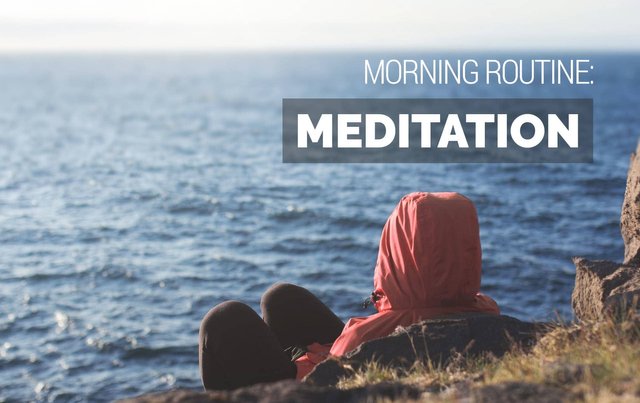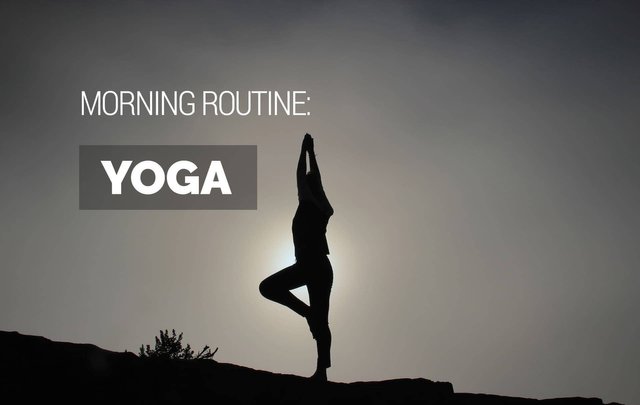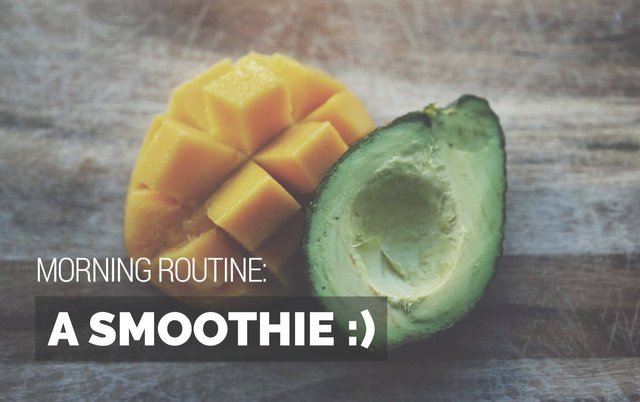This Morning Routine Gave Me a Massive Quality of Life Boost

You’ve heard about psychological health impacting physical health. It’s more than likely that you’ve personally experienced it. You’re stressed – you catch a cold. You’re worried – you get an upset stomach. Prolonged psychological anxiety can lead to much worse symptoms. But what about the other way around? Can improvements in physical health improve your mental state? My answer is an unequivocal yes and here I’d like to share a morning routine that I used to give myself a huge boost.
Be warned though: if you're not doing anything remotely similar to this, it will be challenging at first. Not because it is especially hard, but because anything that is not yet a habit and which we do not immediately enjoy feels daunting. That's just how humans are... 🙂
Not The Best of Times
Moody. Easily annoyed at tiny inconveniences. Hardly able to focus on a single task for more than half an hour. This wasn’t the brightest time in my life… It was clear both to me and to those around me that I wasn’t at all at peace mentally; my inner balance was off.
I knew some kind of change was needed. What’s more, I knew that I already had all of the pieces necessary to enact any improvements, but I just couldn’t apply consitently. I could enter meditative states, but they didn’t last long, or if they did, they’d be dropped again in a few days. Fitness was sporadic: a brief jog one week, a yoga session the next, nothing the week after.
Enough was enough.
Stop Deciding, Start Doing
Here’s what I realised… There’s something about the thinking process behind decisions that can actually hinder the decision itself. It goes something like this: “I’ve just woken up. OK, this is the day. I will start my mornings better from now on. I will start getting fitter. Yeah, that’s what I’ll do. First I’ll do this, then that. That’s my new morning routine.”
And before you know it, you’ve thought it all through but yet again haven’t actually done anything. It’s like the thoughts about changing your action pattern started a closed loop that you’re not allowed to get out of!
So, how do you overcome this and actually do what you want to do? The answer is stupidly simple: you just do it. Don’t think about doing it. Do it. Take that first step, lift that arm, whatever, but actually do it. INSTANTLY. Don’t give your mind a chance to close the loop and lead you into yet another day of not doing what you know you should be doing.
It was only after realising this subtle hurdle and starting the routine without first thinking that it became a reality. Every day is the same: I get right into the physical actions necessary to start.
Do This 5-6 Times a Week
I chose this specific order for the morning routine’s step because if felt like the most natural progression from one to the next. No other reason.
1. Meditation
Start with a brief concentration meditation. How long it lasts is entirely up to you, but make sure you leave enough time for the other steps. Sit down, close your eyes, and take a few deep breaths. Choose something to focus on. It could be your nose, your chest, your hands, or the blackness in front of your closed eyes. A lot of people recommend focusing on your breathing. Don’t try to control it. Just pay attention to the expansion and contraction of the chest and the feeling of the air rushing in and out of your nose. Calmly brush away any distracting thoughts and refocus your attention. Make this your sole focus. Ten to fifteen minutes is a good initial aim.
Doing this daily will enable you to start the day with a calm, sharp, focused mind. In the long term it will also begin to bring a lot more insight and balance into your thoughts and emotions.

You can also work toward a lotus pose while meditating. Start with a half-lotus posture. If it becomes painful, give it about 10-15 seconds. If the pain persists, release and try with the other leg. Once you can comfortably stay in half-lotus for up to 15 minutes, start changing the leg that you put on top each day. After a few weeks, start trying a full-lotus posture for as long as you can, releasing into half-lotus when the pain is too much. What this will do is very effectively stretch the muscles around your hips, knees, and lower legs. In today’s world of sitting down in front of a screen for hours on end, it’s definitely needed!
2. Oxygenation
Breathing never sounded so cool, but not I’m talking about your average, boring breathing. I’m talking about Wim Hof’s method. Called The Iceman for his feats withstanding cold temperatures, Wim Hof has created a streamlined course to allow anyone to learn to control their body in a similar way.
It’s a 10-week programme made up of gradually-enhanced breathing exercises, stretching exercises, and cold showers (more on this below). Doesn’t sound like much, right? I followed the course and let me tell you – the second week hadn’t ended and the effects were already being felt!
For the breathing part, you do several sets of about 30-40 deep, relatively quick breaths (completely fill your lungs with force, let go without force), followed by a final exhale, and then not breathing for as long as possible. You’re oxygenating your blood, lowering CO2 concentration, and getting the body to utilise the built up oxygen more effectively. Three weeks in I was holding my breath – with empty lungs – for just under four minutes! This brief description doesn’t do this practice justice. Check out the full course. It's a bit pricey (and that's NOT an affiliate link, by the way 🙂 ), but the physical and mental effect it had on me is profound, so I consider it worth the price...
3. Yoga
After starting with a brief meditation and then the specific breathwork, I move on to yoga. What yoga is great for is first of all stretching and toning your body. Daily psychological stressors make us physically tense and a lack of movement during office work is a barrier to the body’s natural capacity to stay healthy. Yoga helps to reverse both of these issues. The chance to spend some time listening to your body should also not be underestimated.
Also, working through and beyond some physical pain is great mental training for life in general. You become better and better at overcoming obstacles to achieve results.

Below is my recommended yoga plan, composed of a set of mostly basic asanas (poses) that I’ve found to very elegantly flow from one to another. Every part of your body gets some attention and the smooth transitions should make the whole routine easier to memorize. That said, if this seems a bit too much, feel free to mix and match as you see fit. Just make sure to keep a balanced focus on shoulders, back, neck, legs, and hips.
Assuming you’re just starting with yoga, all of these pose names won’t mean anything to you. Check out the gaia.com yoga pose directory, which includes images and step by step instructions.
A word of warning: if you’ve never done any yoga, I recommend attending a few classes first so that an instructor can show you how to do a lot of these poses properly. If you don’t have the basic principles in places, you might either not get a strong enough stretch or – worse yet – get hurt from doing a pose wrong or too forcefully.
- Start with the Tree pose. Switch to your other leg.
- Do 3 sets of Sun Salutations.
- Go into Warrior I.
- Bend forward. Place elbows and forearms on the ground inside and slightly in front of your bent leg. Hold.
- Put one palm on the floor under your face and go into the Extended Side Angle pose. Reverse the pose by switching hands and turning your chest to the opposite side.
- Go into Downward Facing Dog.
- Repeat steps 3-5 but with your other leg.
- Go into Download Facing Dog.
- Lift one of your legs up so that the leg is parallel with the arms, hold it, then bend the knee, and stack the hips (open them so they’re vertical rather than horizontal)
- Go into the Pigeon pose with the leg that is bent. Hold it and lower your body over the bent leg, arms extended forward.
- Back into Downward Facing Dog.
- Repeat steps 9-10, but with your other leg.
- Back into Downward Facing Dog.
- Now do one smooth action to curve, lower down, and then up into the Cobra pose.
- Hold it and then lower your body down with your chin on the floor. Go into the Locust pose.
- Palms at face level and push away and backwards into an Extended Child’s pose. Hold.
- Lift up onto all fours, hands under you shoulders, and do alternating Cat and Cow poses.
- Stop. Lift your left arm forward, straight, shoulder level, while lifting your right leg back, straight, shoulder level.
- Back onto all fours and then repeat step 18 but with the opposite arm and leg.
- Go back into Downward Facing Dog.
- Walk your palms toward your feet and lift up.
- Go into Warrior II pose.
- Hold it and then into Reverse Warrior.
- Back into Warrior II, bring back hand forward, interlock the fingers and lunge forward over the bent leg.
- Straighten knees and rotate feet to the opposite side. Repeat 22-24 with the other leg.
- Straighten knees and rotate feet back to the other side again. Go into Extended Triangle pose. Hold and switch hands into Revolved Triangle pose.
- Straighten knees and rotate feet to the opposite side. Repeat 26 with other leg.
- Straighten knees, and open your legs as wide as you can on the mat, feet facing forward. Hold your elbows and bend forward between your legs, head hanging down.
- Then, elbows and forearms on the ground, head on the ground as well if you can. Again, try to open your legs as wide as you can.
- Hold, then up on your palms and jump (or slowly wiggle) into feet together, then up into Chair pose.
- Sit down fully and go into Seated Forward Bend.
- Then, do the Half Lord of the Fishes. (Love that name! 😂 ) Hold and repeat on the opposite side.
- Lie down, feet together, hands at hips.
- Raise your legs to a 90 degree angle (Uttanpadasana). Use your core muscles, so you shouldn’t feel your lower spine touching the ground hard.
- Lower excruciatingly slowly back down so that your core is maximally engaged.
- Lift again into 90 degrees.
- From here you can either do a Shoulder Stand and then gently into a Plow pose, or do a Upward Bow (Wheel) pose. Or do both if you’re able to – they balance each other out. If you’re doing the Shoulder Stand into Plow, tuck your shoulder blades under your body as best as you can, and then lift your hips toward the ceiling, supporting your lower/middle back with your hands. Be very gentle with the Plow pose and fully use your hands on the floor to support yourself slowly coming back down.
- Lie down flat. You’re done.
- BONUS: Headstand.
That may look like a lot, but it only takes me about 20 minutes. That’s plenty, even though it can easily be stretched out a lot longer by staying in each pose for 30 seconds to a minute.
4. Jogging
The key here is to jog until you’re close to your limit every single time. This means sweating (the heavier the better), being almost out of breath, and calves aching. In the final 50-100 meters, speed up into a sprint to finish. Doesn’t matter how tired you are – sprint.
If you’ve rarely ever jogged, or haven’t been regularly jogging in a long time, the first few times will be rough. It’s fine to pause several times during the run. Just don’t completely stop and bend over, gasping for air. Keep walking for 30 seconds to 1 minute max, then continue. Stretch your thighs and calves really well before and after each session.
After three or so sessions, start pushing yourself further every time. Add 20-50 meters of overall distance to the jog. Finish with a longer sprint. Finish with a faster sprint. After a month or so, start to slowly increase the overall speed of the jog. Find hilly terrain. Challenge yourself.
Pro Tip: breathe in when your right foot touches the ground, breathe in when your left foot touches the ground.
Pro Tip 2: jog on your toes or midfoot, not on your heels.
5. Cold Shower
Brrrr! This takes some willpower the first few times, but it’s so worth it both long- and short term. This is part of the Wim Hof course that I mentioned above, but this step is actually something that I’ve had in mind for a long time anyway. Several Northern European, Eastern European, and Asian cultures have traditions involving maintenance and improvement of health through the extremes of saunas and ice-holes or snow. There’s a reason for that and this part of the morning routine touches that ancient spirit.

The way you start during the first week is enjoying your hot shower as usual, then taking about 30 seconds to mentally prepare, and switching the water to fully cold for 30 seconds. Don’t just let the water fall on one part of the body. Let the cold water flow everywhere. End the shower after that. During the second week, you alternate between hot and cold a couple of times during each showering session. In the third week you both start and end with a minute-long cold shower. And so on.
What this will do is strengthen your autonomic nervous system and immune system. Plus, you’ll start enjoying the hot portion of any shower a lot more. 😉
6. A Smoothie
Is this a necessary part of the routine? Here’s how I see it… First, it’s a great nutritional boost. You’ve just physically stressed your body a little bit, so it needs some protein, carbs, fats, vitamins, and minerals to rebuild and recharge. It’s also part of the fuel for the rest of the day.
Don’t skip the full breakfast though. Have breakfast after your routine as you normally would. Why not before starting it? Research has shown that having breakfast after morning physical activity may actually be more beneficial across the board.
Apart from that, it’s just a nice treat. Healthy smoothies don’t have to taste bad! In fact, it’s very easy to make the greenest of smoothies taste more like healthy desserts than medical treatments.
Here’s my base recipe:
- I use a leaf of kale and a leaf of spinach almost every single time. By a leaf I mean something pretty much the size of my hand.
- Often, I also throw in either a leaf of chard or lettuce as well. I’ve got a garden patch where all four of these things are growing (and you can easily grow them on your windowsill, for example) but you should have no trouble finding them. Go for organic if possible.
- Half a large banana goes in as well. This gives it a bit of a smooth bulkiness and eases the taste.
- A heaped tablespoon of chunky peanut butter. Nice portion of protein and overall cohesion.
- A splash of agave syrup or honey for sweetness.
- Sometimes I add a prune or two, maybe a date instead (both pitted, obviously). Play around with it. Try berries. Try mango or avocado.
- I also add a tablespoon of moringa powder and a teaspoon of lucuma powder. Superfoods.
- Sometimes I throw in a few tablespoons of coconut yoghurt or a splash of goat’s milk kefir. Adds a creamy texture, plus they’re full of probiotics.
- Half a cup to a full cup of water. Tweak the exact amount to get the taste and consistency right for you. Start with less and add more after. Easier to make it less thick than to add thickness!
- Blend for about 30 seconds. Doesn’t matter if there are tiny unblended pieces. Enjoy it!

Rest
I recommend that you do this routine 5-6 times a week. Why not everyday? As any fitness coach should tell you, the body needs rest. Even if you’re not intensely stressing your muscles at the gym, the jogging and even the yoga can have a big enough impact to begin with. If you haven’t been jogging regularly, your legs will be hurting quite a bit during the first week. A lot of yoga poses require shoulder and core strength, so prepare for some soreness there as well. No pain, no gain.
Your body doesn’t need a lot of time to recover, but it does need some time. At the very least take one day off from this routine. Try to have it on the same day(s) every week to establish a mental pattern that is easier to maintain. What this will also allow you to do is set up a fitness habit that you can develop further. For example, you might start doing some weight training. That definitely needs rest days, but you already have some in your weekly schedule so you’ll more easily plan around them!
So, Are You Ready To Improve Your Quality of Life?
Almost certainly, but you probably have a few lingering questions.
How long does this take to do?
On average I spend an hour and a half on this routine. If you think you don’t have that much time every morning, you’ve got two options:
- Wake up earlier.
- Trim the routine. You can make the jog shorter but more intense, and/or remove a few poses from the yoga section.
I have trouble getting out of bed…
Check out this great advice someone posted over on Reddit.
Do I have to do this in the morning?
You can certainly do it whenever you want. I find that the morning is ideal since it wakes you up really well and you get a chance to focus on just yourself in the morning before the day comes crashing down on you. 🙂
Start Tomorrow
It will take a few days to get into the swing of things and a few weeks to turn this routine into a habit that you actually want to maintain.
It’s worth it.